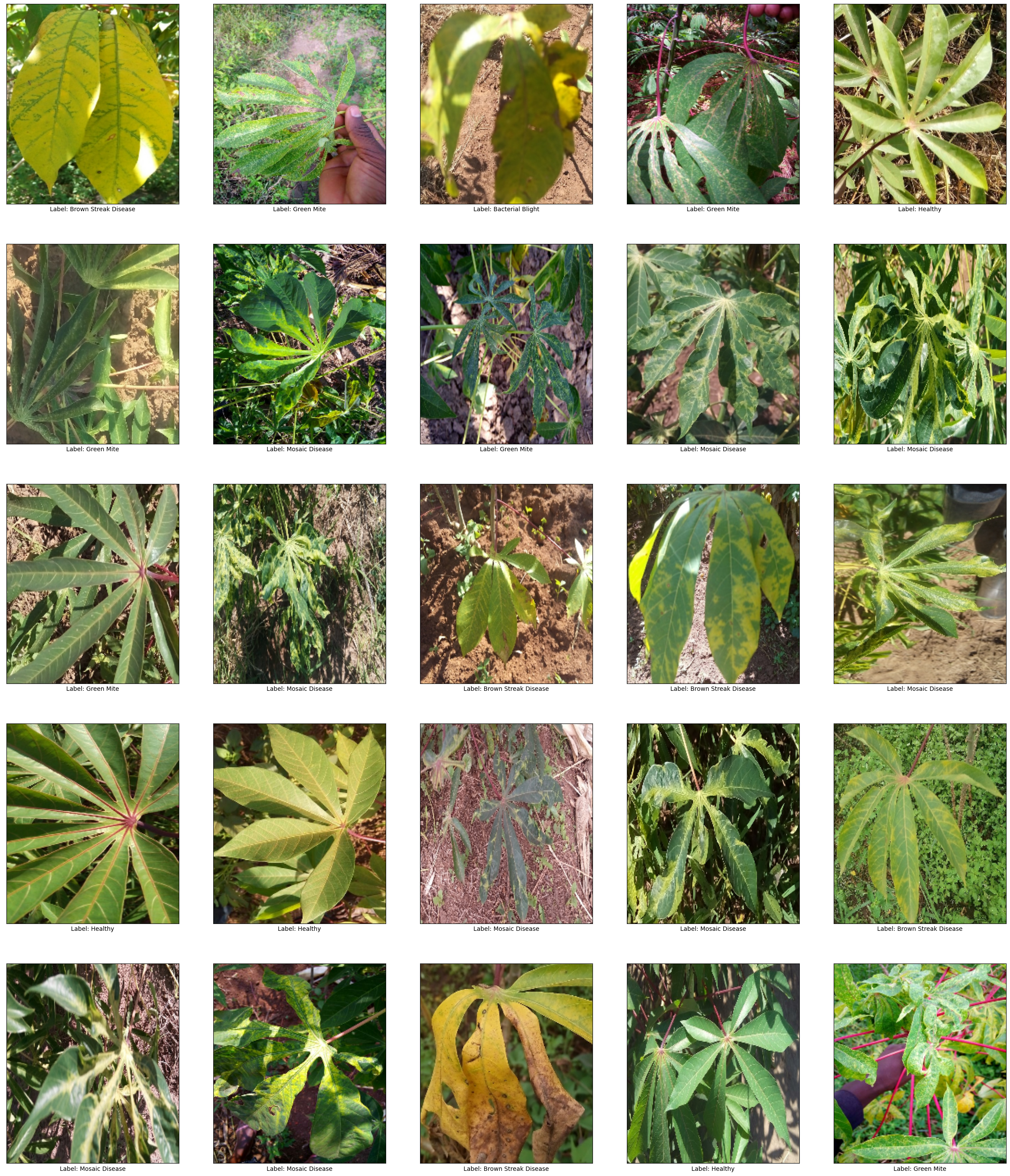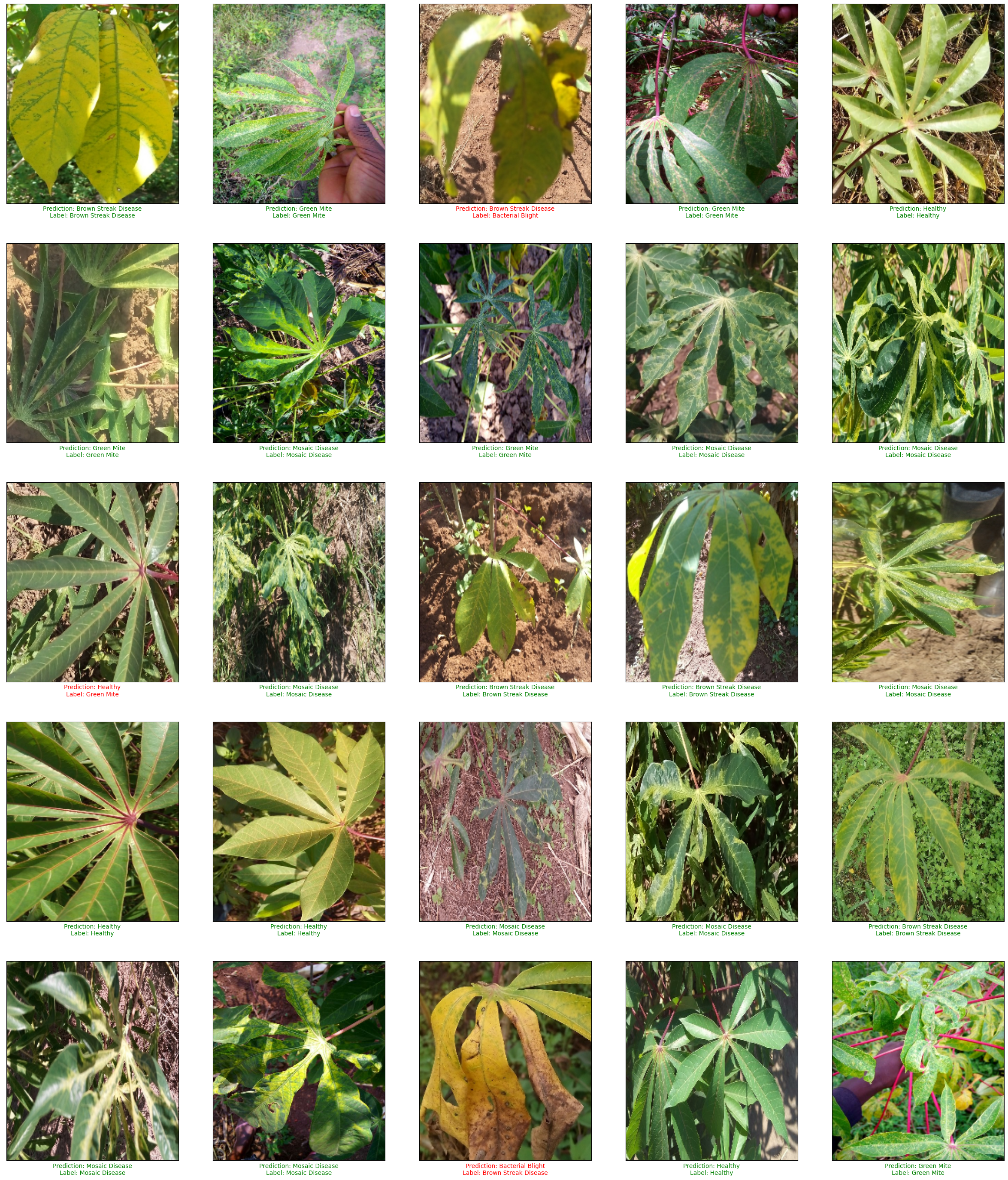 TensorFlow.org पर देखें TensorFlow.org पर देखें |  Google Colab में चलाएं Google Colab में चलाएं |  गिटहब पर देखें गिटहब पर देखें |  नोटबुक डाउनलोड करें नोटबुक डाउनलोड करें |  टीएफ हब मॉडल देखें टीएफ हब मॉडल देखें |
इस नोटबुक से पता चलता है कि कैसे CropNet उपयोग करने के लिए कसावा रोग वर्गीकारक TensorFlow हब से मॉडल। बैक्टीरियल तुषार, भूरे रंग लकीर रोग, हरी घुन, मोज़ेक रोग, स्वस्थ, या अज्ञात: 6 वर्गों में से एक में कसावा पत्तियों के मॉडल का वर्गीकरण छवियों।
यह कोलाब दर्शाता है कि कैसे:
- लोड https://tfhub.dev/google/cropnet/classifier/cassava_disease_V1/2 TensorFlow हब से मॉडल
- लोड कसावा TensorFlow डेटासेट से डाटासेट (TFDS)
- कसावा के पत्तों की छवियों को 4 अलग कसावा रोग श्रेणियों में या स्वस्थ या अज्ञात के रूप में वर्गीकृत करें।
- कैसे मजबूत मॉडल जब डोमेन छवियों से बाहर करने के लिए लागू है पर वर्गीकारक और देखो की सटीकता का मूल्यांकन करें।
आयात और सेटअप
pip install matplotlib==3.2.2
import numpy as np
import matplotlib.pyplot as plt
import tensorflow as tf
import tensorflow_datasets as tfds
import tensorflow_hub as hub
उदाहरण प्रदर्शित करने के लिए सहायक कार्य
def plot(examples, predictions=None):
# Get the images, labels, and optionally predictions
images = examples['image']
labels = examples['label']
batch_size = len(images)
if predictions is None:
predictions = batch_size * [None]
# Configure the layout of the grid
x = np.ceil(np.sqrt(batch_size))
y = np.ceil(batch_size / x)
fig = plt.figure(figsize=(x * 6, y * 7))
for i, (image, label, prediction) in enumerate(zip(images, labels, predictions)):
# Render the image
ax = fig.add_subplot(x, y, i+1)
ax.imshow(image, aspect='auto')
ax.grid(False)
ax.set_xticks([])
ax.set_yticks([])
# Display the label and optionally prediction
x_label = 'Label: ' + name_map[class_names[label]]
if prediction is not None:
x_label = 'Prediction: ' + name_map[class_names[prediction]] + '\n' + x_label
ax.xaxis.label.set_color('green' if label == prediction else 'red')
ax.set_xlabel(x_label)
plt.show()
डेटासेट
आइए लोड TFDS से कसावा डाटासेट
dataset, info = tfds.load('cassava', with_info=True)
आइए इसके बारे में अधिक जानने के लिए डेटासेट जानकारी पर एक नज़र डालें, जैसे विवरण और उद्धरण और कितने उदाहरण उपलब्ध हैं, इसके बारे में जानकारी
info
tfds.core.DatasetInfo(
name='cassava',
full_name='cassava/0.1.0',
description="""
Cassava consists of leaf images for the cassava plant depicting healthy and
four (4) disease conditions; Cassava Mosaic Disease (CMD), Cassava Bacterial
Blight (CBB), Cassava Greem Mite (CGM) and Cassava Brown Streak Disease (CBSD).
Dataset consists of a total of 9430 labelled images.
The 9430 labelled images are split into a training set (5656), a test set(1885)
and a validation set (1889). The number of images per class are unbalanced with
the two disease classes CMD and CBSD having 72% of the images.
""",
homepage='https://www.kaggle.com/c/cassava-disease/overview',
data_path='gs://tensorflow-datasets/datasets/cassava/0.1.0',
download_size=1.26 GiB,
dataset_size=Unknown size,
features=FeaturesDict({
'image': Image(shape=(None, None, 3), dtype=tf.uint8),
'image/filename': Text(shape=(), dtype=tf.string),
'label': ClassLabel(shape=(), dtype=tf.int64, num_classes=5),
}),
supervised_keys=('image', 'label'),
disable_shuffling=False,
splits={
'test': <SplitInfo num_examples=1885, num_shards=4>,
'train': <SplitInfo num_examples=5656, num_shards=8>,
'validation': <SplitInfo num_examples=1889, num_shards=4>,
},
citation="""@misc{mwebaze2019icassava,
title={iCassava 2019Fine-Grained Visual Categorization Challenge},
author={Ernest Mwebaze and Timnit Gebru and Andrea Frome and Solomon Nsumba and Jeremy Tusubira},
year={2019},
eprint={1908.02900},
archivePrefix={arXiv},
primaryClass={cs.CV}
}""",
)
कसावा डाटासेट 4 अलग बीमारियों के साथ कसावा पत्तियों के साथ-साथ स्वस्थ कसावा के पत्तों की छवियों है। मॉडल इन सभी वर्गों के साथ-साथ छठी कक्षा को "अज्ञात" के लिए भविष्यवाणी कर सकता है जब मॉडल अपनी भविष्यवाणी में आश्वस्त नहीं होता है।
# Extend the cassava dataset classes with 'unknown'
class_names = info.features['label'].names + ['unknown']
# Map the class names to human readable names
name_map = dict(
cmd='Mosaic Disease',
cbb='Bacterial Blight',
cgm='Green Mite',
cbsd='Brown Streak Disease',
healthy='Healthy',
unknown='Unknown')
print(len(class_names), 'classes:')
print(class_names)
print([name_map[name] for name in class_names])
6 classes: ['cbb', 'cbsd', 'cgm', 'cmd', 'healthy', 'unknown'] ['Bacterial Blight', 'Brown Streak Disease', 'Green Mite', 'Mosaic Disease', 'Healthy', 'Unknown']
इससे पहले कि हम मॉडल को डेटा फीड कर सकें, हमें कुछ प्रीप्रोसेसिंग करने की आवश्यकता है। मॉडल [0, 1] में RGB चैनल मानों के साथ 224 x 224 छवियों की अपेक्षा करता है। आइए छवियों को सामान्य और आकार दें।
def preprocess_fn(data):
image = data['image']
# Normalize [0, 255] to [0, 1]
image = tf.cast(image, tf.float32)
image = image / 255.
# Resize the images to 224 x 224
image = tf.image.resize(image, (224, 224))
data['image'] = image
return data
आइए डेटासेट से कुछ उदाहरण देखें
batch = dataset['validation'].map(preprocess_fn).batch(25).as_numpy_iterator()
examples = next(batch)
plot(examples)

नमूना
आइए टीएफ हब से क्लासिफायर को लोड करें और कुछ भविष्यवाणियां प्राप्त करें और देखें कि मॉडल की भविष्यवाणियां कुछ उदाहरणों पर हैं
classifier = hub.KerasLayer('https://tfhub.dev/google/cropnet/classifier/cassava_disease_V1/2')
probabilities = classifier(examples['image'])
predictions = tf.argmax(probabilities, axis=-1)
plot(examples, predictions)

मूल्यांकन और मजबूती
के डेटासेट के विभाजन पर हमारे वर्गीकारक की सटीकता मापें। हम यह भी एक गैर कसावा डेटासेट पर उसके प्रदर्शन का मूल्यांकन द्वारा मॉडल की मजबूती देख सकते हैं। INaturalist या सेम की तरह अन्य पौधे डेटासेट की छवि के लिए, मॉडल लगभग हमेशा अज्ञात लौटना चाहिए।
मापदंडों
DATASET = 'cassava'
DATASET_SPLIT = 'test'
BATCH_SIZE = 32
MAX_EXAMPLES = 1000
def label_to_unknown_fn(data):
data['label'] = 5 # Override label to unknown.
return data
# Preprocess the examples and map the image label to unknown for non-cassava datasets.
ds = tfds.load(DATASET, split=DATASET_SPLIT).map(preprocess_fn).take(MAX_EXAMPLES)
dataset_description = DATASET
if DATASET != 'cassava':
ds = ds.map(label_to_unknown_fn)
dataset_description += ' (labels mapped to unknown)'
ds = ds.batch(BATCH_SIZE)
# Calculate the accuracy of the model
metric = tf.keras.metrics.Accuracy()
for examples in ds:
probabilities = classifier(examples['image'])
predictions = tf.math.argmax(probabilities, axis=-1)
labels = examples['label']
metric.update_state(labels, predictions)
print('Accuracy on %s: %.2f' % (dataset_description, metric.result().numpy()))
Accuracy on cassava: 0.88
और अधिक जानें
- TensorFlow हब पर मॉडल के बारे में अधिक जानें: https://tfhub.dev/google/cropnet/classifier/cassava_disease_V1/2
- कैसे के साथ एक मोबाइल फोन पर एक कस्टम छवि वर्गीकारक चल बनाने का तरीका जानें एमएल किट के साथ इस मॉडल की TensorFlow लाइट संस्करण ।
